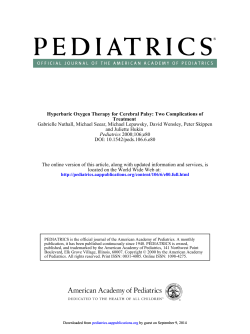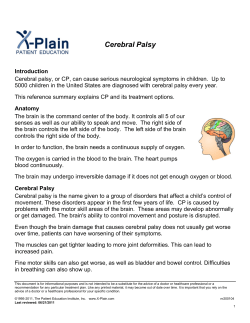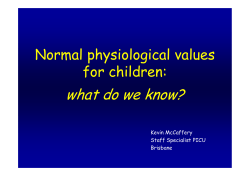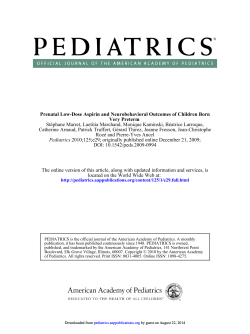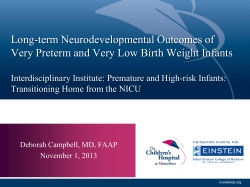
Living a Normal Life With the Nondominant Hemisphere: Magnetic Resonance
Living a Normal Life With the Nondominant Hemisphere: Magnetic Resonance Imaging Findings and Clinical Outcome for a Patient With Left-Hemispheric Hydranencephaly Stephan Ulmer, Friederike Moeller, Marc A. Brockmann, Johann P. Kuhtz-Buschbeck, Ulrich Stephani and Olav Jansen Pediatrics 2005;116;242 DOI: 10.1542/peds.2004-0425 The online version of this article, along with updated information and services, is located on the World Wide Web at: http://pediatrics.aappublications.org/content/116/1/242.full.html PEDIATRICS is the official journal of the American Academy of Pediatrics. A monthly publication, it has been published continuously since 1948. PEDIATRICS is owned, published, and trademarked by the American Academy of Pediatrics, 141 Northwest Point Boulevard, Elk Grove Village, Illinois, 60007. Copyright © 2005 by the American Academy of Pediatrics. All rights reserved. Print ISSN: 0031-4005. Online ISSN: 1098-4275. Downloaded from pediatrics.aappublications.org by guest on June 9, 2014 Living a Normal Life With the Nondominant Hemisphere: Magnetic Resonance Imaging Findings and Clinical Outcome for a Patient With Left-Hemispheric Hydranencephaly Stephan Ulmer, MD*; Friederike Moeller, MD*; Marc A. Brockmann, MD‡; Johann P. Kuhtz-Buschbeck, MD, PhD§; Ulrich Stephani, MD, PhD㛳; and Olav Jansen, MD, PhD* ABSTRACT. In hemihydranencephaly, the human brain lacks 1 complete hemisphere. An occlusion of the carotid artery, affecting all supplied territories, is thought to be the underlying mechanism. This extremely rare disorder, of which only 7 cases have been reported to date, is thought to occur before the last trimester of gestation (20th to 27th week), after neural migration but before synaptogenesis. We report on a 36-year-old man born at term, with no complications, from nonconsanguineous healthy parents. Cranial computed tomography had been performed because of left-sided headaches. Because of the imaging findings, the patient presented at our institution for additional MRI and clinical testing (including the Motor Activity Log, Wolf motor function test, 2-point discrimination test, Purdue pegboard test, gross motor function test, Physician Rating Scale, and Aachener aphasia test, including patterns for spontaneous speech, repetition, naming, comprehension, written language, and the token test). The patient’s disabilities were related to deficits in fine motor control and reduced precision. Therefore, the patient was unable to perform the Purdue pegboard test with his affected hand. According to the Aachener aphasia test, no aphasia could be demonstrated for this strongly left-handed patient. Strong mirror movements were found. Cortical reorganization is possible if damage occurs in very early childhood. Motor function and speech were controlled by the remaining, nonaffected hemisphere, with a remarkable outcome. Because the damage is thought to occur before synaptogenesis, existing or prepared cortical areas and pathways have the potential to execute the lacking functions of the destroyed hemisphere. Pediatrics 2005;116: 242–245; adult outcomes, brain development, brain imaging, cerebral infarction, functional assessment, children. H emihydranencephaly is an extremely rare disorder in which the human brain lacks 1 complete hemisphere. Occlusion of the ipsilateral carotid artery occurring before the last trimester of gestation (20th to 27th week of gestation) is From the *Section of Neuroradiology, Department of Neurosurgery, and 㛳Department of Neuropediatrics, University Hospital of Schleswig-Holstein, Kiel, Germany; ‡Institute of Radiology, University Hospital of Schleswig-Holstein, Luebeck, Germany; and §Institute of Physiology, Christian Albrechts University, Kiel, Germany. Accepted for publication Oct 14, 2004. doi:10.1542/peds.2004-0425 No conflict of interest declared. Reprint requests to (S.U.) Institute of Radiology, University Hospital of Schleswig-Holstein, Ratzeburger Allee 160, 23538 Luebeck, Germany. Email: ulmer@email.com PEDIATRICS (ISSN 0031 4005). Copyright © 2005 by the American Academy of Pediatrics. 242 thought to be the underlying mechanism for this brain damage, which affects all of the supplied territories.1,2 It is still not known why this disorder affects only 1 hemisphere. The circle of Willis does not seem to be able to compensate for the demands in the developing brain. In the adult brain, occlusion of a brain-supplying vessel results in a territorial infarction; postischemic defects and gliotic changes can be observed on MRI scans. Here, the circle of Willis and sufficient leptomeningeal collateral vessels can compensate for vessel occlusion, so that only partial territorial infarction occurs. In principle, these mechanisms should also work in the prenatal and perinatal periods. Therefore, fetal predisposing conditions, leading to additional vascular aplasia with vessel occlusion, are suspected for patients with hemihydranencephaly. The brain damage is assumed to occur after neural migration and before synaptogenesis.3 Only 7 cases have been reported to date. With perinatal brain damage, there is always an attempt to predict clinical outcomes according to computed tomographic and/or MRI findings.4–11 However, even for patients with large parenchymal defects, clinical outcomes may be excellent.2,12 CASE REPORT We present the case of a 36-year-old man born at term, with no complications, from nonconsanguineous healthy parents, as the second son among 3 otherwise healthy children. The parents noticed some clumsiness in early childhood. Right-sided hemiparesis and an equinus deformity at the ankle were diagnosed, with surgical treatment at the age of 18 years. During childhood, the patient received physical therapy. Additional sensorimotor and language development during childhood was not restricted. At the age of 28 years, the patient experienced his only general seizure. The rest of his medical history was unremarkable. Our patient was and is not receiving any medication. Intellect and language were unimpaired; the patient could complete school and is now working in a security department. He reported some disabilities concerning fine motor control of his affected right hand in tasks of daily living but had no other complaints. At the time of our investigation, a computed tomographic study had been performed at a different institution, where the patient had presented with left-sided headaches and nuchal pain. Because of his symptoms and the imaging findings, the patient presented at our institution. We performed MRI and magnetic resonance angiography with a 1.5-T scanner (Magnetom Vision; Siemens, Erlangen, Germany). MRI scans demonstrated a nearly complete absence of the left hemisphere, which was replaced by cerebrospinal fluid. Only a small residual hippocampus, a small rim of the occipital cortex, and a small cerebral peduncle attributable to Wallerian degeneration could be identified on the left side (Fig 1). However, the cerebellum, which is usually supplied by the posterior vascular PEDIATRICS Vol. 116 No. 1 July 2005 Downloaded from pediatrics.aappublications.org by guest on June 9, 2014 Fig 1. Coronal, T1-weighted, MRI scans (A and B), T2-weighted MRI scans (sagittal in C and axial in D and E), and a time-of-flight angiogram (F) for a patient with hemihydranencephaly. There was a nearly complete absence of the left hemisphere, which was replaced by cerebrospinal fluid. Only a small residual hippocampus, a small rim of the occipital cortex (black arrows), and a small cerebral peduncle (black arrowhead) could be identified on the left side. However, the cerebellum, which is usually supplied by the posterior vascular territory, was completely normal. Time-of-flight angiography (F) demonstrated the absence of the left internal carotid artery (white dot). The right internal carotid artery was without pathologic findings, separating into the middle cerebral artery and the anterior cerebral artery. Because of moderately but chronically increased intracranial pressure, the bone of the skull was narrowed (white arrows). territory, was completely normal. Time-of-flight angiography demonstrated the absence of the left internal carotid artery. Because conventional grading of hemiparesis (as proposed by the Medical Research Council in 196413) was thought to be too inaccurate to describe the extent of motor disability, we performed additional motor and language tests. Self-assessment was performed with the Motor Activity Log.14 The patient reported that he is able to drive a car with a standard transmission. Although natural prehension movements are almost unimpaired, the patient is unable to open a door with a key, button or unbutton clothing, switch between television programs with a remote control, turn the pages of a newspaper, use a spoon or fork while eating, put on socks, or brush his hair with the disabled hand. For the upper extremity, the Wolf motor function test,15 2-point discrimination test, and Purdue pegboard test16,17 were used to examine gross and fine motor function. In the Wolf motor function test, the patient scored 64 of 85 possible points (75%), because of reduced speed and/or precision in almost all of the performed tasks and because of impaired fine motor control in 3 tasks. Functionality and quality of movement did not differ in terms of the score. The threshold for 2-point discrimination in pinprick testing was 10 mm for the examined dermatomes (C5–C7) on the affected side. In the Purdue pegboard test, the patient was unable to perform any required task with the affected hand. Strong mirror movements were found when the patient was moving both hands.18 For the lower extremity, we performed the gross motor function test, part E.19 Because of incomplete performance and the inability to jump with the affected leg alone, the patient scored 93 of 100 possible points on the gross motor function test. With the Physician Rating Scale,20 only 10 of a total of 14 points were scored, because of impairment in the patient’s ankle. For language testing, the Aachener aphasia test,21 a standardized, German, reference test for spontaneous speech, repetition, naming, comprehension, and written language, was administered, including the token test. The results confirmed our impression that speech was not affected, according to the criteria for aphasia of the Aachener aphasia test. The token test was completed correctly. The patient is strongly left-handed (92%, according to the handedness test described by Milner et al22). DISCUSSION Hemihydranencephaly is a rare disorder. To our knowledge, only 7 other cases have been reported in the literature.2,23–29 Hemiparesis on the contralateral side was observed in 5 of those cases,2,25–29 mild mental retardation in 4,2,25,26,28,29 severe retardation in 1,27 and seizures in 1.27 In two publications,23,24 the clinical outcome was not reported for 1 patient, who died at the age of 4 years, as a result of bronchopneumonia.23 The immature brain may compensate for neuronal injury through cortical reorganization that is superior to such capacities in the adult brain.12,30–33 Our patient is remarkable for several reasons. First, according to previous reports, severe hemiparesis would have been expected, considering the subtotal hemispheric damage.4,5,7,34,35 Second, the left hemisphere is thought to be the dominant side, harboring speech areas; however, speech is not impaired. Third, living with only 1 hemisphere could lead to severe intellectual impairment; however, our patient has completed school and is integrated fully in social life. Fourth, according to the current literature, this is the oldest patient alive and healthy, living an almost normal life. According to the results of the clinical tests, especially the Wolf motor function test, disabilities were related to deficits in fine motor control, as predicted with the Motor Activity Log, and reduced speed and/or reduced precision of the performed tasks and inability to perform 3 of the tasks. Quality of motion was not significantly worse with respect to functionality if the patient was able to execute a movement. Fine motor control requires unaffected 2-point dis- EXPERIENCE AND REASON Downloaded from pediatrics.aappublications.org by guest on June 9, 2014 243 crimination; therefore, the patient was unable to perform the tasks of the Purdue pegboard test with his affected right hand. Mirror movements are thought to be caused by loss of transcallosal inhibition.36,37 Among patients with cerebral palsy, studies with transcranial magnetic brain stimulation revealed that branching corticospinal fibers projecting both ipsilaterally and contralaterally were associated with strong mirror movements.31,38,39 In congenital hemiparesis, motor function can be controlled by the nonaffected hemisphere through ipsilateral pathways.12,30–33 In their transcranial magnetic brain stimulation study, Carr et al31 demonstrated projections innervating both left and right motoneuron pools of homologous muscles simultaneously, with distally pronounced mirror movements. Our findings are in accordance with those of others, demonstrating that cortical reorganization is possible if the damage occurs in very early childhood.30,40 However, Ogden40 reported that severe deficits of complex extrapersonal orientation ability, spatial memory, and higher cognitive visuospatial skills might occur as a result of right-hemispheric speech dominance. He concluded that a shift of language representation to the right side might cause “crowding of function” in the remaining hemisphere, which might lead to deficits in spatial memory and orientation. Our patient demonstrates that normal development of verbal skills after left-hemispheric brain damage does not necessarily compromise memory or spatial orientation. We cannot predict with certainty from the morphometric features whether a child will develop impaired motor and/or higher cognitive functions. Some patients with only minor lesions are hampered severely, and it is still unclear what determines clinical outcomes. Activation of already existing pathways, development of new connections, or axonal migration or sprouting may be responsible for patients being able to achieve almost normal skills. Because the lesion is thought to occur before synaptogenesis,3 it seems most likely that already existing or prepared pathways that have the potential to execute the lacking functions of the destroyed hemisphere are used in this disease. Although there must be a genetic predisposition to define the precentral gyrus as the motor cortex, cortical areas may exist in the immature brain that can adopt similar or contralateral functions and enable cortical plasticity, with protocols executed through the uncrossed corticospinal fibers. REFERENCES 1. Myers RE. Cerebral ischemia in the developing primate fetus. Biomed Biochim Acta. 1989;48:S137–S142 2. van Doornik MC, Hennekam RC. Hemi-hydranencephaly with favourable outcome. Dev Med Child Neurol. 1992;34:454 – 458 3. Eyre JA, Miller S, Clowry GJ, Conway EA, Watts C. Functional corticospinal projections are established prenatally in the human foetus, permitting involvement in the development of spinal motor centres. Brain. 2000;123:51– 64 4. Wiklund LM, Uvebrant P, Flodmark O. Computed tomography as an adjunct in etiological analysis of hemiplegic cerebral palsy, II: children born at term. Neuropediatrics. 1991;22:121–128 244 5. Wiklund LM, Uvebrant P. Hemiplegic cerebral palsy: correlation between CT morphology and clinical findings. Dev Med Child Neurol. 1991;33:512–523 6. Molteni B, Oleari G, Fedrizzi E, Bracchi M. Relation between CT patterns, clinical findings and etiological factors in children born at term, affected by congenital hemiparesis. Neuropediatrics. 1987;18:75– 80 7. Kotlarek F, Rodewig R, Brull D, Zeumer H. Computed tomographic findings in congenital hemiparesis in childhood and their relation to etiology and prognosis. Neuropediatrics. 1981;12:101–109 8. Steinlin M, Good M, Martin E, Banziger O, Largo RH, Boltshauser E. Congenital hemiplegia: morphology of cerebral lesions and pathogenetic aspects from MRI. Neuropediatrics. 1993;24:224 –229 9. Uvebrant P. Hemiplegic cerebral palsy: aetiology and outcome. Acta Paediatr Scand Suppl. 1988;345:1–100 10. Cioni G, Sales B, Paolicelli PB, Petacchi E, Scusa MF, Canapicchi R. MRI and clinical characteristics of children with hemiplegic cerebral palsy. Neuropediatrics. 1999;30:249 –255 11. Niemann G, Wakat JP, Krageloh-Mann I, Grodd W, Michaelis R. Congenital hemiparesis and periventricular leukomalacia: pathogenetic aspects on magnetic resonance imaging. Dev Med Child Neurol. 1994;36: 943–950 12. Kuhtz-Buschbeck JP, Dreesmann M, Golge M, Stephani U. Prenatal infarction of the left middle cerebral artery: a case report of excellent functional outcome. NeuroRehabilitation. 2000;15:167–173 13. Monrad-Krohn GHRS. The Clinical Examination of the Nervous System. 12th ed. New York, NY: Harper and Row; 1964 14. Taub E, Miller NE, Novack TA, et al. Technique to improve chronic motor deficit after stroke. Arch Phys Med Rehabil. 1993;74:347–354 15. Wolf SL, LeCraw DE, Barton LA, Jann BB. Forced use of hemiplegic upper extremities to reverse the effect of learned nonuse among chronic stroke and head-injured patients. Exp Neurol. 1989;104:125–132 16. Tiffin J, Asher EJ. The Purdue pegboard: norms and studies of reliability and validity. J Appl Psychol. 1948;32:234 –247 17. Reddon JR, Gill DM, Gauk SE, Maerz MD. Purdue pegboard: test-retest estimates. Percept Mot Skills. 1988;66:503–506 18. Woods BT, Teuber HL. Mirror movements after childhood hemiparesis. Neurology. 1978;28:1152–1157 19. Russell DJ, Rosenbaum PL, Cadman DT, Gowland C, Hardy S, Jarvis S. The gross motor function measure: a means to evaluate the effects of physical therapy. Dev Med Child Neurol. 1989;31:341–352 20. Koman LA, Mooney JF III, Smith B, Goodman A, Mulvaney T. Management of cerebral palsy with botulinum-A toxin: preliminary investigation. J Pediatr Orthop. 1993;13:489 – 495 21. Huber W, Poeck K, Weniger D, Willmes K. Aachener Aphasietest: AAT. Goettingen, Germany: Hogrefe; 1983 22. Milner B, Branch C, Rassmussen T. Observations on cerebral dominance. In: De Rueck AVS, O’Conner M, eds. Ciba Foundation Symposium on Disorders of Language. London, United Kingdom: Churchill; 1964 23. Muir CS. Hydranencephaly and allied disorders: a study of cerebral defect in Chinese children. Arch Dis Child. 1959;34:231–246 24. Warkany I. Congenital Malformations: Notes and Comments. Chicago, IL: Year Book Medical; 1971 25. Moser RP, Seljeskog EL. Unilateral hydranencephaly: case report. Neurosurgery. 1981;9:703–705 26. Suzuki M, Seki H, Yoshimoto T. Unilateral hydrocephalus combined with occlusion of the ipsilateral internal carotid artery. Surg Neurol. 1985;24:27–30 27. Ohtsuka H. A rare patient with a false median cleft lip associated with multiple congenital anomalies. Ann Plast Surg. 1986;17:155–160 28. Porro G, Wittebol-Post D, de Graaf M, Van Nieuwenhuizen O, SchenkRootlieb AJ, Treffers WF. Development of visual function in hemihydranencephaly. Dev Med Child Neurol. 1998;40:563–567 29. Greco F, Finocchiaro M, Pavone P, Trifiletti RR, Parano E. Hemihydranencephaly: case report and literature review. J Child Neurol. 2001;16:218 –221 30. Cao Y, Vikingstad EM, Huttenlocher PR, Towle VL, Levin DN. Functional magnetic resonance studies of the reorganization of the human hand sensorimotor area after unilateral brain injury in the perinatal period. Proc Natl Acad Sci USA. 1994;91:9612–9616 31. Carr LJ, Harrison LM, Evans AL, Stephens JA. Patterns of central motor reorganization in hemiplegic cerebral palsy. Brain. 1993;116: 1223–1247 32. Lewine JD, Astur RS, Davis LE, Knight JE, Maclin EL, Orrison WW Jr. Cortical organization in adulthood is modified by neonatal infarct: a case study. Radiology. 1994;190:93–96 33. Nirkko AC, Rosler KM, Ozdoba C, Heid O, Schroth G, Hess CW. MRI FINDINGS AND OUTCOME IN HEMIHYDRANENCEPHALY Downloaded from pediatrics.aappublications.org by guest on June 9, 2014 34. 35. 36. 37. Human cortical plasticity: functional recovery with mirror movements. Neurology. 1997;48:1090 –1093 Eliasson AC, Gordon AM, Forssberg H. Basic co-ordination of manipulative forces of children with cerebral palsy. Dev Med Child Neurol. 1991;33:661– 670 Forssberg H, Eliasson AC, Redon-Zouitenn C, Mercuri E, Dubowitz L. Impaired grip-lift synergy in children with unilateral brain lesions. Brain. 1999;122:1157–1168 Nass R. Mirror movement asymmetries in congenital hemiparesis: the inhibition hypothesis revisited. Neurology. 1985;35:1059 –1062 Heinen F, Kirschner J, Fietzek U, Glocker FX, Mall V, Korinthenberg R. Absence of transcallosal inhibition in adolescents with diplegic cerebral palsy. Muscle Nerve. 1999;22:255–257 38. Carr LJ. Development and reorganization of descending motor pathways in children with hemiplegic cerebral palsy. Acta Paediatr Suppl. 1996;416:53–57 39. Farmer SF, Harrison LM, Ingram DA, Stephens JA. Plasticity of central motor pathways in children with hemiplegic cerebral palsy. Neurology. 1991;41:1505–1510 40. Ogden JA. Visuospatial and other “right-hemispheric” functions after long recovery periods in left-hemispherectomized subjects. Neuropsychologia. 1989;27:765–776 QUALITY OF CARE BY NEONATAL NURSE PRACTITIONERS: A REVIEW OF THE ASHINGTON EXPERIMENT “The Ashington experiment, an innovative neonatal service run entirely by advanced neonatal nurse practitioners (ANNPs), has been evaluated. This is a report of that evaluation and a review of the benefits, hazards, and implications of nurse practitioner–led services. . . . In summary, the Ashington experience has shown that ANNPs can provide a high standard of neonatal care without a doctor on site; it has established the conditions needed for a successful introduction of this model of care; it has highlighted the difficulties in measuring quality of care (a lesson that undoubtedly applies to other aspects of health care as well as neonatology); and it has presented a challenge to the health professions to create and test innovative ways of sustaining services that otherwise might have to be closed.” Hall D, Wilkinson AR. Arch Dis Child Fetal Neonatal Ed. 2005;90:F195–F200 Noted by JFL, MD EXPERIENCE AND REASON Downloaded from pediatrics.aappublications.org by guest on June 9, 2014 245 Living a Normal Life With the Nondominant Hemisphere: Magnetic Resonance Imaging Findings and Clinical Outcome for a Patient With Left-Hemispheric Hydranencephaly Stephan Ulmer, Friederike Moeller, Marc A. Brockmann, Johann P. Kuhtz-Buschbeck, Ulrich Stephani and Olav Jansen Pediatrics 2005;116;242 DOI: 10.1542/peds.2004-0425 Updated Information & Services including high resolution figures, can be found at: http://pediatrics.aappublications.org/content/116/1/242.full.ht ml References This article cites 36 articles, 10 of which can be accessed free at: http://pediatrics.aappublications.org/content/116/1/242.full.ht ml#ref-list-1 Citations This article has been cited by 5 HighWire-hosted articles: http://pediatrics.aappublications.org/content/116/1/242.full.ht ml#related-urls Subspecialty Collections This article, along with others on similar topics, appears in the following collection(s): Neurology http://pediatrics.aappublications.org/cgi/collection/neurology _sub Psychiatry/Psychology http://pediatrics.aappublications.org/cgi/collection/psychiatry _psychology_sub Permissions & Licensing Information about reproducing this article in parts (figures, tables) or in its entirety can be found online at: http://pediatrics.aappublications.org/site/misc/Permissions.xht ml Reprints Information about ordering reprints can be found online: http://pediatrics.aappublications.org/site/misc/reprints.xhtml PEDIATRICS is the official journal of the American Academy of Pediatrics. A monthly publication, it has been published continuously since 1948. PEDIATRICS is owned, published, and trademarked by the American Academy of Pediatrics, 141 Northwest Point Boulevard, Elk Grove Village, Illinois, 60007. Copyright © 2005 by the American Academy of Pediatrics. All rights reserved. Print ISSN: 0031-4005. Online ISSN: 1098-4275. Downloaded from pediatrics.aappublications.org by guest on June 9, 2014
© Copyright 2025



